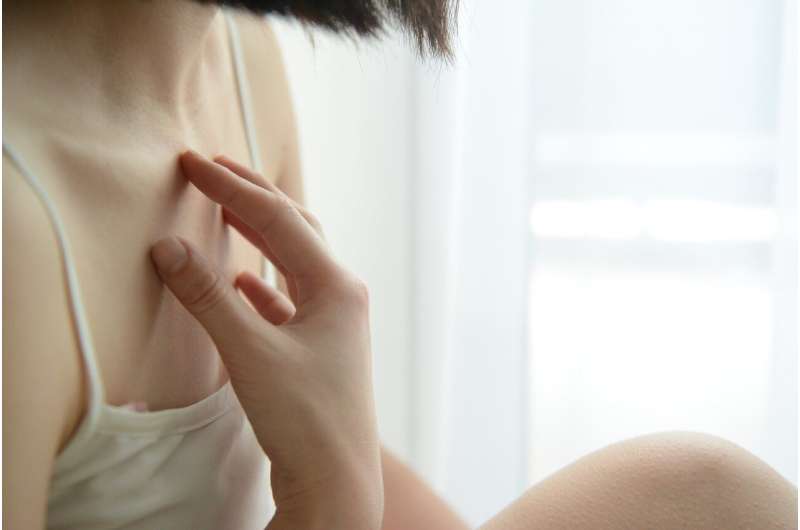Upadacitinib in moderate to severe atopic dermatitis: High doses produce added benefit for adults

Upadacinib is a new drug for the treatment of adults and adolescents aged 12 years and older with moderate to severe atopic dermatitis who are candidates for systemic therapy. In an early benefit assessment, the German Institute for Quality and Efficiency in Health Care (IQWiG) has now examined whether the drug has an added benefit for the patients. The appropriate comparator therapy is dupilumab, which can be combined with topical calcineurin inhibitors and topical glucocorticoids as required.
Adequate study data are only available for adult patients who received the higher of the two approved doses; they show both positive and negative effects. These data result in a hint of considerable added benefit in women and a hint of major added benefit in men. However, an added benefit is not proven for younger patients and for the lower dose of upadacitinib.
Study does not cover the entire approval
The manufacturer presented data from the double-blind randomized controlled trial Heads-Up, which compared upadacitinib and dupilumab over a 24-week period. The study investigated adults who had had moderate to severe atopic dermatitis for at least three years. Moreover, they had to have responded inadequately to topical therapies with glucocorticoids and/or calcineurin inhibitors or to systemic therapies before, or topical treatment was not advisable for them, for example due to side effects.
Patients in the intervention arm received 30 mg upadacitinib per day, i.e. the higher of the two approved doses. Treatment with the 15 mg dose also approved for patients from 18 to 64 years of age was neither allowed at the start of the study nor in its further course.
Uncertainty about effects of lower dose
The Summary of Product Characteristics on upadacitinib does not provide any concrete specifications on the choice of the dose, but the results of further approval studies suggest a dose-dependent efficacy. It can therefore be assumed that the lower dose is indicated for less severe cases. Since the study mainly included severely affected patients, its results are in principle suitable to assess an added benefit despite the restriction to the higher dose; however, at most hints can be derived.
As the efficacy depends on the dose, positive effects resulting from treatment with the 15 mg dosage of upadacitinib may only be equal to or slightly greater than those resulting from treatment with the appropriate comparator therapy. Based on the study, an added benefit can only be assessed for the higher dose.
Evidence not transferable to adolescents
For adolescents, only the lower upadacitinib dose is approved. Transfer of the results from adults to adolescents is not possible, as treatment in the Heads-Up study was restricted to the higher dose. Due to the dose-dependent efficacy of upadacitinib, the study data only allow the derivation of an added benefit for adult patients for whom 30 milligrams represent the appropriate dose.
Clear advantages in symptoms, more frequent severe side effects in women
The study data show both positive and negative effects of upadacitinib in comparison with dupilumab. The age of those affected and the severity of their dermatitis only modify the effects for some non-serious or non-severe side effects, so that no differentiation needs to be made here in the conclusion of the assessment.
The effect modification by the characteristic "sex" is more significant: women—like men—benefit from positive effects, each with the extent "major", in the symptoms-related outcomes "remission" and "itching", and from a positive effect with the extent "considerable" in the outcome "patient-reported symptoms". For women—but not for men—this is accompanied by greater harm with the extent "major" in the overall rate of severe side effects, which reduces the added benefit.
For adult women for whom 30 mg is the appropriate dose, this results in a hint of considerable added benefit. For adult men, there is a hint of major added benefit.
For adults for whom 15 mg is the appropriate dose as well as for adolescents, an added benefit is not proven.
G‑BA decides on the extent of added benefit
The dossier assessment is part of the early benefit assessment according to the Act on the Reform of the Market for Medicinal Products (AMNOG) supervised by the G-BA. After publication of the dossier assessment, the G-BA conducts a commenting procedure and makes a final decision on the extent of the added benefit.
More information: Assessment of Upadacitinib (in German): www.g-ba.de/bewertungsverfahre … nutzenbewertung/735/

















